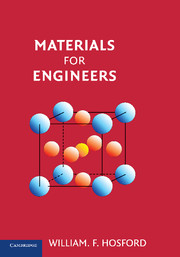Book contents
- Frontmatter
- Contents
- Preface
- 1 Introduction
- 2 Phases
- 3 Diffusion
- 4 Mechanical Behavior
- 5 Mechanical Failure
- 6 Annealing
- 7 Iron and Steel
- 8 Nonferrous Metals
- 9 Casting and Welding
- 10 Solid Shaping
- 11 Polymers
- 12 Polymer Processing
- 13 Glasses
- 14 Crystalline Ceramics
- 15 Powder Processing
- 16 Pottery and Concrete
- 17 Composites
- 18 Carbon
- 19 Fibers, Foams, and Porous Materials
- 20 Electrical Properties
- 21 Optical and Thermal Properties
- 22 Magnetic Materials
- 23 Corrosion
- 24 Modern Manufacturing Techniques, Surface Treatments, and Recycling
- APPENDIX 1 Wood
- APPENDIX 2 Miller Indices for Planes and Directions
- APPENDIX 3 X-ray Diffraction
- APPENDIX 4 Surfaces
- APPENDIX 5 Dislocations
- APPENDIX 6 Avrami Kinetics
- APPENDIX 7 Organic Chemistry
- APPENDIX 8 Average Molecular Weight
- APPENDIX 9 Bond Geometry in Compounds
- APPENDIX 10 Weibull Analysis
- Index
- Conversions
1 - Introduction
Published online by Cambridge University Press: 05 June 2012
- Frontmatter
- Contents
- Preface
- 1 Introduction
- 2 Phases
- 3 Diffusion
- 4 Mechanical Behavior
- 5 Mechanical Failure
- 6 Annealing
- 7 Iron and Steel
- 8 Nonferrous Metals
- 9 Casting and Welding
- 10 Solid Shaping
- 11 Polymers
- 12 Polymer Processing
- 13 Glasses
- 14 Crystalline Ceramics
- 15 Powder Processing
- 16 Pottery and Concrete
- 17 Composites
- 18 Carbon
- 19 Fibers, Foams, and Porous Materials
- 20 Electrical Properties
- 21 Optical and Thermal Properties
- 22 Magnetic Materials
- 23 Corrosion
- 24 Modern Manufacturing Techniques, Surface Treatments, and Recycling
- APPENDIX 1 Wood
- APPENDIX 2 Miller Indices for Planes and Directions
- APPENDIX 3 X-ray Diffraction
- APPENDIX 4 Surfaces
- APPENDIX 5 Dislocations
- APPENDIX 6 Avrami Kinetics
- APPENDIX 7 Organic Chemistry
- APPENDIX 8 Average Molecular Weight
- APPENDIX 9 Bond Geometry in Compounds
- APPENDIX 10 Weibull Analysis
- Index
- Conversions
Summary
Properties
One material is chosen over another for a particular application because its properties are better suited for the intended use. Among the important properties are strength, corrosion resistance, electrical conductivity, weight, material cost, processing costs, and appearance. Usually several properties are important.
In many applications, stiffness is important. Materials deform when a stress is applied to them. If the stress is low, the deformation will be elastic. In this case the deformation will disappear and the material will regain its original shape when the stress is removed. Good examples are elastic bands and paper clips. With greater stress, a material may deform plastically. In this case the deformation does not disappear when the stress is removed, so the shape change is permanent. This happens when the stress exceeds the yield strength of the material. With a still higher stress, the material may reach its tensile strength and fail. Ductility and toughness are also important. The ductility of a material is the amount of deformation a material may undergo before breaking. Toughness is a measure of how much energy a material absorbs per area before fracture.
Electrical properties are of paramount importance in some applications. Electrical conductors should have high conductivities and insulators very low conductivities. Integrated circuits for computers require semiconductors. The dielectric constant may be important in applications involving high frequencies. Piezoelectric behavior is required for sonar transmitters and receivers.
- Type
- Chapter
- Information
- Materials for Engineers , pp. 1 - 7Publisher: Cambridge University PressPrint publication year: 2008



